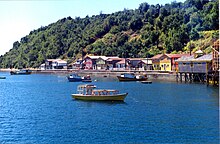Queilen
Queilen is a municipality ( Comuna ) in southern Chile on the east coast of the island of Chiloé in the Región de los Lagos .
Location and districts
The distance to Castro , the capital of the province of Chiloe, is 63 km. In the north the area of the municipality of Chonchi borders on Queilen, in the south that of the municipality of Quellón . The community of Queilen is 223.9 km² and consists of the small town of the same name and the following 19 villages:
- Agoni
- Leibun
- Pio Pio
- Aituy
- Detico
- San Miguel
- Contuy
- Paildad
- Apeche
- Apeche Alto
- Puleo
- Diaz Lira
- Acui on the offshore island of Isla Acui
- Centinela, Millahue, Alqui, Nepué, San José and Tranqui on the offshore island of Isla Tranqui
population
The 2002 census counted 5,138 inhabitants, of which 1,912 lived in the city of Queilen. In the villages belonging to Queilen lived 3,226 people (62.8%), 67 of them on the island of Acui and 270 on the Isla Tranqui. From 1992 to 2002 the population of Queilen rose by 3.8% (186 inhabitants).
history
The official date of the city's foundation is February 9, 1778, but there was a settlement of the Indians with a chapel here at the beginning of the 18th century, which was expanded into a church in 1771. Between 1818 and 1821 a Spanish cavalry general explored the area, in honor of which the city was renamed "Puerto Grille" in 1890. However, this place name remained uncommon among the population and was soon replaced by the old name. After 1900 Queilen experienced an economic boom as a port on the east coast of Chiloé due to the development of forestry. In 1937, a large fire destroyed 15 houses on the Calle Alesandri coastal road . With the expansion of the road network on Chiloé, however, the city and port lost their importance, as Queilen was away from the important land connections. Many people left the city to settle in the easily accessible cities of Castro or Ancud . Only with the construction of the road from Queilen to Chonchi in 1976 did the traffic connections improve. With the growth of the fish processing industry and Chilean inland tourism, the city experienced an economic boom at the end of the 20th century.
Environment and tourism
Tourism is becoming more and more important as an economic factor for Queilen, as the city, which is surrounded on two sides by the sea, has fine sandy beaches that are well suited for swimming and water sports. In the city center, the church, built in 1940 on the central plaza, and the Refugio Para Navegantes museum, founded in 1999 on the coastal promenade next to the renovated Muelle Histórico ferry pier, which was built in 1928–30, are worth mentioning.
From Queilen the upstream, 2 km long and 0.5 km wide Isla Acui with its indigenous population can be reached by boat, as is Isla Tranqui after a 30- minute drive.
The village of Lelbún 15 km north of Queilen with its wooden church from the middle of the 20th century is known for its beach, as is Agoni (20 km north). Typical Chilotic wooden houses made of shingles are still preserved in Agoni. The village of Aituy (8 km to the north) is visited on August 30th for the consecration of the Iglesia Jesús Nazareno, built at the beginning of the 20th century . Nature reserves were created on the densely vegetated lagoons of Paildad and Pio Pio (14 km).
swell
- ↑ La ciudad de Queilén ( Memento of the original of April 14, 2009 in the Internet Archive ) Info: The archive link was automatically inserted and not yet checked. Please check the original and archive link according to the instructions and then remove this notice. (Spanish)
- ↑ Juan Mancilla Pérez: Pueblos de Chiloé , p. 64. Castro 2008.
- ↑ Dominique Verhasselt: Archipielago Chiloé - el encanto de una isla misteriosa , p. 116. Santiago de Chile, no year
- ↑ Jorge Sánchez R .: Chiloé - tradición y cultura , p. 44. Santiago de Chile 2006. ISBN 956-309-024-1
- ↑ Dominique Verhasselt: Archipielago Chiloé - el encanto de una isla misteriosa , p. 117. Santiago de Chile, no year
- ↑ Juan Mancilla Pérez: Pueblos de Chiloé , p. 65. Castro 2008.
Web links
Coordinates: 42 ° 53 ′ S , 73 ° 28 ′ W

